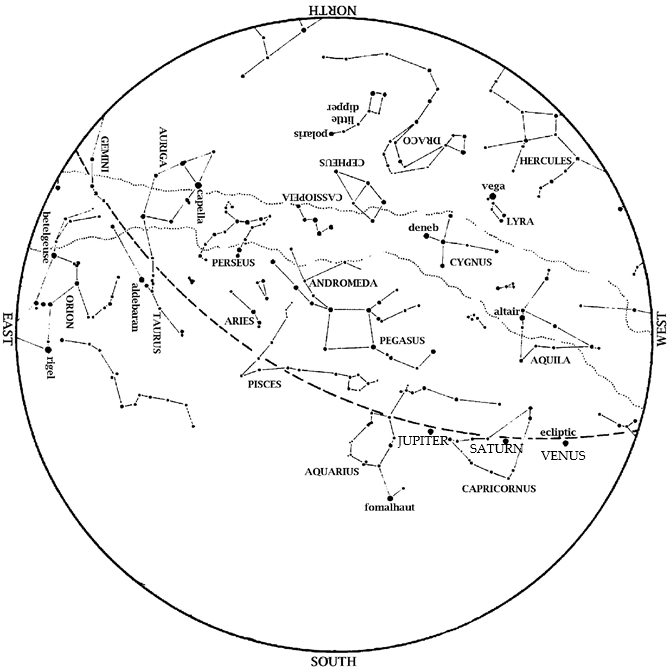Venus remains in the evening sky one more month. Venus outshines everything except the Sun and the Moon, so it is unmistakable low in the southwest at dusk. Late in the month, Venus returns towards the Sun’s glare, where it will become invisible right after New Year’s Day.
Jupiter and Saturn remain well placed for evening observing this fall. Look for Jupiter and Saturn in the southwest as night falls. Jupiter is brighter than all the stars we ever see at night. Saturn, to Jupiter’s lower right, is somewhat dimmer but still outshines all of the stars near it.
Mercury enters the evening sky as Venus leaves it. Look for Mercury to the left of Venus December 29-30, both low to the southwest horizon at dusk.
Mars slowly emerges into the morning sky this month. Look low in the southeast at dawn, over the point of sunrise.
The Summer Triangle sets in the west. Watch for the Great Square of Pegasus almost overhead at dusk now and in the west by Christmas. Taurus, the Bull rises in the east. Look for the Pleiades star cluster above reddish Aldebaran. Dazzling Orion, the Hunter rises shortly after dusk (by month’s end, it is already up at dusk). As Orion enters the evening sky, we transition from the relatively dim evening skies of autumn to the brilliant stars of winter. We are beginning to face away from the center of the galaxy, looking at stars behind us in our own part of our galaxy (the Orion Spur).

The Summer Triangle sets in the west. The Great Square of Pegasus is high in overhead. Across the southern sky, we see a region of only dim stars, where only Fomalhaut stands out. Venus, Jupiter, and Saturn form a line in the southwest at dusk. Taurus, the Bull, rises in the east, joined by Orion, the Hunter.
These stars herald the coming winter.
Moon Phases in December 2021:
New December 4, 1:43 a.m.
1st Quarter December 10, 7:36 p.m.
Full December 18, 10:36 p.m.
Last Quarter December 26, 8:24 p.m.
The New Moon of December 4 casts its shadow on the Earth, causing a total eclipse. However, the shadow lands on Antarctica, which is thus the only place to see totality.
At 9:59 am on Tuesday, December 21, the Sun is overhead as seen from the tropic of Capricorn, the farthest point south where this is possible. That’s because Earth’s North Pole is now tilted as far as possible away from the Sun. That’s why this is our winter solstice, the day when we have more night and less daylight than any other. Below the equator, this is the summer solstice because the South Pole is tilted towards the Sun as much as possible.
You will notice, however, that sunset on New Year’s Eve is up to ten minutes later than on December 1. Why, if the 31st is closer to the solstice? Although the shortest day (least daylight) occurs on December 21, the earliest sunset occurs for us about December 1. This is because the Sun’s apparent position in our sky varies like a sine wave; there is little difference in the Sun’s apparent height for about a month before and after the solstice. Due to Earth’s tilt, the Sun does indeed take a shorter, lower path across the sky on December 21 than on December 1, but only by about 1.5 degrees (your pinky at arm’s length blocks one degree). Meanwhile, Earth is slightly accelerating as it approaches perihelion just after the new year. This makes both sunrise and sunset happen a little earlier each night during December. Near the solstice, this small effect can dominate. Since most of us sleep through sunrise and watch sunset, days seem to lengthen from December 1-21 when they are in fact still getting shorter.
The is a possibility of a naked-eye comet, Comet Leonard, this month. It’s just a ‘possibility’ because comet brightness is unpredictable, and this is its first close pass since its discovery at the beginning of the year. Try to find it near the southwest horizon at dusk after December 14, shifting towards the south (left) each evening. It will appear directly between Venus and the horizon on December 17, and between Saturn and the horizon December 19-20.
Our George Observatory is now open every Saturday night for observing! Purchase tickets in advance on our website.
Clear Skies!
Look back to November’s Sky Happenings.







